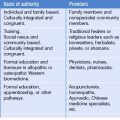CHAPTER 9 Cultural Competence
Healthcare Disparities and Political Issues
Background
Cultural competence has recently gained increasing attention from healthcare policy makers, providers, insurers, and educators as a strategy to improve quality of care and eliminate racial/ethnic disparities in healthcare. Cultural competence is grounded in two basic principles:1 first, it is important to explore and understand the sociocultural factors that influence a patient’s values, beliefs, and behaviors related to health and healthcare; and second, it is critical to develop multilevel strategies in the design and delivery of healthcare in an effort to bridge the gaps in quality that result from sociocultural and linguistic barriers. Ultimately, the goal of cultural competence is to create a healthcare system and workforce that are capable of delivering the highest quality of care to every patient, regardless of race, ethnicity, culture, or language proficiency. Such a system would be equitable, of high quality, and free of disparities based on individual patient characteristics. Bringing this to fruition requires action by various sectors of healthcare, yet each may have different motivations, approaches, and leverage points for advancing cultural competence.
Cultural Competence Emerges
Cultural competence has emerged as an important healthcare issue for three very practical reasons. First, as the US becomes more diverse, clinicians will increasingly see patients with a broad range of thoughts regarding health and well-being, oftentimes influenced by their social or cultural background. Culture can be seen as an integrated pattern of learned beliefs and behaviors that can be shared among groups and includes thoughts, styles of communicating, ways of interacting, views on roles and relationships, values, practices and customs. Culture is shaped by multiple influences, including race, ethnicity, nationality, language, and gender, but also extending to socioeconomic status, physical and mental ability, sexual orientation, and occupation, among others. For instance, patients may present their symptoms quite differently from the way healthcare providers have read about them in their medical textbooks; they may have limited English proficiency, thus limiting their ability to communicate; they may have different thresholds for seeking care, or expectations about the care they receive; and they may hold beliefs that in-fluence whether or not they adhere to our recommendations.2
Second, research has shown that effective provider–patient communication is directly linked to improved patient satisfaction, adherence and, subsequently, health outcomes.3 Thus, patient dissatisfaction, nonadherence, and poorer health outcomes may result when sociocultural differences between the patient and the provider are not effectively addressed in the clinical encounter.4 This is further complicated by situations in which the patient has limited English proficiency or low health literacy. Ultimately, these barriers do not just apply to minority groups (African-Americans, Hispanics, Asian, Pacific Islanders, and Native Americans/Alaska Natives: taken from US Office of Management and Budget definition [OMB-15 Directive]), but may just be more pronounced in these cases.
Finally, two recent Institute of Medicine Reports – Crossing the Quality Chasm5 and Unequal Treatment6 – both highlighted the importance of patient-centered care, evidence-based guidelines, and cultural competence as a means of improving quality, achieving equity, and eliminating the significant racial/ethnic disparities in healthcare that persist today. These recommendations are based on the premise that improving health systems and provider–patient communication are important components of addressing racial and ethnic disparities in healthcare that occur even when variations in such factors as insurance status, income, age, comorbid conditions, stage of presentation, and symptom expression are taken into account.
In our previous research1,7 we have described three main levels of cultural competence in healthcare:
Perspectives from the Field
A total of 37 interviews were completed in the Spring and Summer of 2002 (individuals and affiliations listed in Appendix). Interviews were taped, transcribed, and qualitatively coded by three independent coders according to a coding structure that disseminated major themes according to frequency and relevance. The coding scheme was designed and overseen by a qualitative methods expert, and the final themes were reviewed for content appropriateness by an expert in cultural competence. Below, we describe the major issues that arose among the different stakeholder groups.
Government
Key capacities of cultural competence
Cultural competence as one step toward eliminating disparities
The Culturally and Linguistically Appropriate Services (CLAS) Standards project was often referred to as an effective blueprint for improving the cultural competence of our healthcare system. (This project was developed by the Office of Minority Health and can be found at http://www.omhrc.gov/clas)








